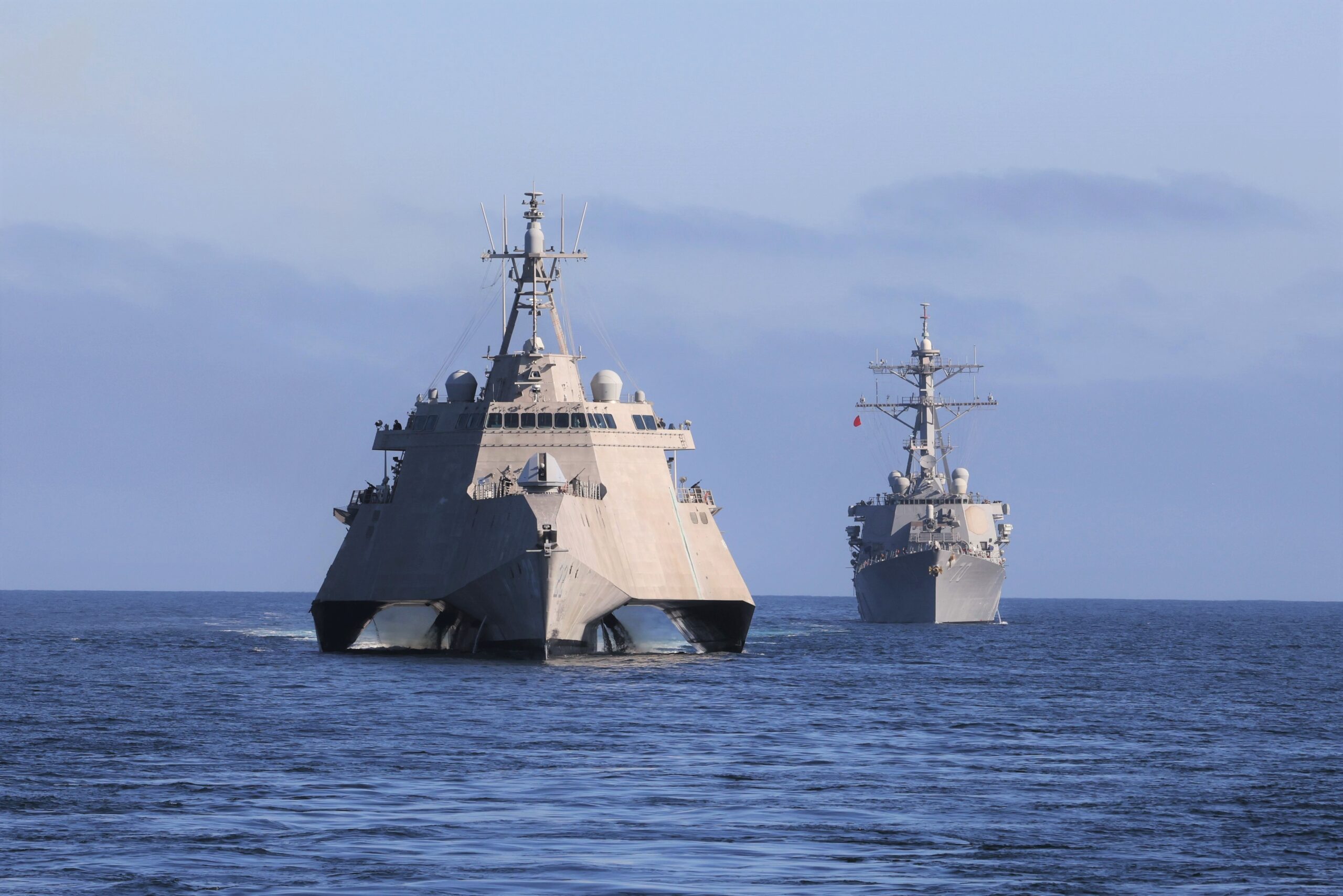The latest incident to befall the U.S. Navy’s troubled Littoral Combat Ship (LCS) was an embarrassingly public one, and one that left the brand-new USS Cleveland (LCS-31) damaged in the process of being launched, in front of around 3,000 people, including members of the media. The Navy has now issued a statement providing more details of the collision between the Cleveland — which is the last of the 16-strong Freedom class — and a tugboat involved during the warship’s recent christening.

“No personnel injuries occurred, but there was limited damage” to the Cleveland, the Navy said, of the April 14 incident. “The damaged area is well above the waterline and no flooding occurred.”
Different videos of the incident, at the Fincantieri Marinette Marine shipyard, in Marinette, Wisconsin, show the ceremonial bottle of sparkling wine being broken over the bow of the Cleveland by Robyn Modly, the wife of the former Under Secretary of the Navy Thomas B. Modly.
Using a side-launch process, the sled-mounted Cleveland is then pulled into the Menominee River by the tugboat William C. Gaynor, attached to it with a bow line. On entering the water, the LCS immediately strikes the tugboat, which was very obviously in much closer proximity to the warship than it should have been at this point. The warship engulfs the tug with an enormous wave and then lurches back and forth before coming to rest in the water.


The Navy described what happened as “unintentional contact … between the ship and a supporting tug.”
The reason for the tug being too close to the Cleveland, according to the Navy, was a simple miscommunication. The Navy and shipbuilder are now investigating further to see how that happened.
Ahead of the launch ceremony, Lockheed Martin released the following video showing how a launch of this kind is supposed to happen:
At the same time, the shipyard has said it plans to phase out side-launches like this in the future, in favor of a new ship lift — a more controlled method of getting new warships into the water. However, that decision was not directly related to the Cleveland incident. Other options for launching larger vessels include sending them stern-first down a slipway, but this requires deeper water and is likely not an option on the Menominee River.
A previous video from Lockheed Martin showing the process of moving the Freedom class Littoral Combat Ship USS Milwaukee (LCS-5) from the build facility to the launch site:

Details of the types of repairs that are required have not been disclosed, nor how long the process will take. After that’s done, Cleveland will make its way to its permanent base in Mayport, Florida.
The construction of the Cleveland — 16th and last of the Freedom class in the LCS program — was announced with fanfare by Under Secretary Modly in 2018: “The new USS Cleveland will be able to reach and defend more coastal areas with more agility, and more network firepower than any other class of ship in the world.”
Ahead of the ill-starred launch, Carlos Del Toro, Secretary of the Navy, said that the Cleveland “will be another step closer to joining our fleet, sailing the open seas, continuing to defend our nation, and representing the strong connection our Navy has with the city of Cleveland.”
And while last weekend’s launch mishap struck a blow (quite literally) to the program, it’s far from the first issue to blight the Littoral Combat Ships.

In fact, there have been so many problems that the Navy last year announced plans to decommission nine of the still very young Freedom class vessels, although that might still be reduced to four, based on a recently released draft spending bill from the House Appropriations Committee. Before all this, there had also been suggestions by the Navy to sell the ships off to select allies.
This is an especially unusual move considering that, once the Navy decommissioned the USS Freedom in 2021, the other nine Freedom class LCSs in service were all delivered between 2015 and 2020, making them very young indeed.
The Freedom class, in particular, has been dogged by problems with its propulsion system and the Navy admitted in 2021 that it would take years to implement critical fixes on the vessels it had acquired up to that point. The issue is related to a design flaw that has led to repeated failures in the combining gear. As a result, the vessels can lose the power of their gas turbines, leaving them running on diesel engines only. Instead of top speeds of over 40 knots — a key Navy requirement — the LCSs can only sail at between 10 to 12 knots on the diesel engines alone.
As well as this, the LCSs in general — the other type being the Independence class — have proven notably expensive to operate and maintain. In 2021, The War Zone reported that their running costs are almost as much as the far more advanced and capable Arleigh Burke class destroyer. Specifically, a single LCS costs around $70 million a year to run, compared to approximately $81 million for an Arleigh Burke class destroyer.

On top of all this, the actual operational capabilities of the LCSs have been successively scaled back. The original plans to have three different specialized modular mission packages that could quickly be swapped out to increase operational flexibility were long ago abandoned. Despite the relatively limited capabilities as a result, there has been some progress made in terms of weaponry, with the new Naval Strike Missile being integrated on a growing number of Independence class ships.
Propulsion problems and other issues have had a major effect on the operational careers of both the LCS types and it wasn’t until May last year that the Freedom class USS Sioux City became the first of either type to be deployed to European and Middle Eastern waters — exactly the areas that the Navy had originally planned for these ships to excel in many years ago.
However long it takes to repair the USS Cleveland — and at what cost — remains to be seen. But it’s a sad fact of the troubled nature of the program that this high-profile incident is likely to be ultimately remembered as a footnote in the Littoral Combat Ship program. On the other hand, critics of the program might also observe that the problematic launch ceremony was a fitting way to close out the construction of the 16-ship Freedom class.
Contact the author: thomas@thedrive.com
